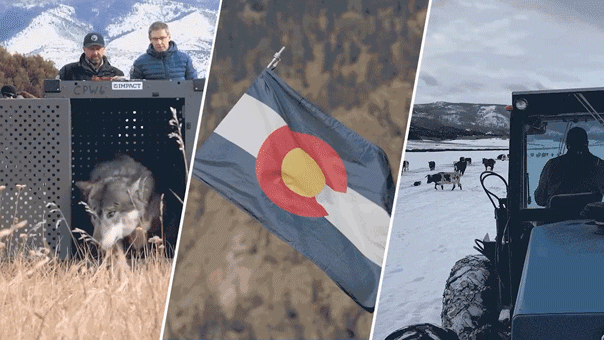
Colorado voters narrowly decided to reintroduce gray wolves to the western part of the state, sparking tensions with ranchers who feel their way of life is under attack.
Editor’s note: This story is the first in a series about wolf reintroduction in Colorado.
GRAND COUNTY, Colo. — Snow swirled in the air as the small crowd of spectators congregated on a patch of state land in Grand County, Colorado, waiting for the wolves to arrive. Finally, after the sun had disappeared behind the mountains, wildlife officials carried out the crates.
A warm, musty, wild scent wafted from the aluminum boxes.
“We could feel [the] energy of the wolves, anticipating that something was about to change,” recalled Rob Edward, co-founder of the Rocky Mountain Wolf Project.
The doors opened. The onlookers waited. Finally, the gray wolves peered out of the crates. They lifted a paw, and then they were off, bounding into the hills roughly 1,000 miles from their original home in eastern Oregon.
The surreal, awe-inspiring sight of gray wolves once again running free in Colorado was the result of nearly 30 years of impassioned work by Edward and other conservationists.
But the wolves’ first confirmed livestock kill just a few months later would spark an intense battle between the apex predators’ primarily urban supporters, and the ranchers who make their living on Colorado’s Western Slope.
“It’s ruined our life,” rancher Conway Farrell said. “They just left us out here to just get murdered by these things.”
Wolves once roamed North America, keeping the population of prey animals like deer and elk in check.
Then in the 1800s, European settlers swept westward, decimating much of the wolves’ prey. Hunting and a U.S. government eradication policy meant to harm Native American tribes nearly wiped out bison by the end of the century. In Colorado, elk were driven to the brink of extinction in the early 1900s.
As cattle and sheep replaced their natural prey, the wolves started eating livestock, prompting a government-sponsored eradication campaign. Men went west wielding cyanide and traps. They laced meat with strychnine to poison hungry wolves, and dug pups out of dens and beat them to death with shovels, Edward said.
“It was a war-level effort,” Edward said. “The spending at the time was on par with what we were spending to arm our military.”
It took nearly three decades, but by the mid-1940s, Colorado’s last wolf had been killed.
TRUMP PLANS TO UNDO OBAMA’S ‘INSULTING’ RENAME OF MT. MCKINLEY; ‘AWFUL IDEA’ SAYS ALASKA REPUBLICAN
Ranchers and livestock associations “didn’t realize the implications” the move would have on the environment, Edward said. By the late 1900s, deer and elk populations had exploded. Without a natural predator, they overgrazed the land, he said, and pointed to the success of wolves in Yellowstone in restoring biodiversity.
“We want wolves here because we know the ecological importance of the species. We want them out there doing what they do best. Just like wildfire when it’s managed properly,” Edward said. “When we suppress those natural processes is when we get into problems.”
Fourth-generation rancher Tim Ritschard sees it differently.
“[Wolves] got eradicated for a reason, and now we’re putting them back on the landscape, yet our population’s probably four times, five times what it was in 1940,” Ritschard said. “It’s just kind of crazy.”
Edward and fellow conservationists’ years of work paid off in November 2020 with the passage of Proposition 114, which mandated that Colorado Parks and Wildlife (CPW) develop a plan to reintroduce wolves.
The proposition passed with just 50.9% of the vote.
“Yeah, it was a narrow margin. But the fact is, wolves won,” Edward said.
VIRGINIA WILDLIFE OFFICIALS TRESPASSED ON MAN’S LAND, STOLE HIS TRAIL CAMERA, LAWSUIT ALLEGES
But the majority of voters in Grand County, where the first gray wolves would ultimately be released, opposed the proposition. Several ranchers Fox News Digital spoke with described feeling shocked by the outcome of the election, and said they wished they had been more vocal in their opposition.
“None of us thought it would pass,” Conway Farrel said. “We were kind of asleep at the wheel.”
Proposition 114 mandated that CPW “take necessary steps to begin reintroduction” of wolves by Dec. 31, 2023. CPW’s 261-page plan outlines a goal of introducing 30-50 wolves to the state over the course of three to five years, then monitoring the wolves to see if their population becomes self-sustaining.
The first five sets of paws hit the ground in Grand County on Dec. 18, 2023. Five more wolves were released in the following days, without announcements beforehand and in undisclosed locations. Attendees at the second release were barred from taking photographs.
Collar data showed the wolves scattering, but eventually two found each other and “set up shop,” producing puppies, Edward said.
“Shortly thereafter, there started to be some livestock killed by that pair of wolves,” he said.
On April 2, 2024, a rancher found the body of a calf lying in the spring snow, surrounded by wolf prints. It was the first confirmed kill.
Every day since then, Grand County Commissioner Merrit Linke says he has heard some complaints about the wolves.
“I think people don’t understand the reality of what’s actually going on here, and they see the wolf as a big, fluffy, friendly creature that runs and lopes wild and free through the woods, just like a big dog,” he said. “There’s a misconception about what actually is the reality of what’s going on with this whole project.”
As more cattle, sheep and other livestock fell prey to Colorado’s new residents, outcry built, culminating in a plea from agricultural groups to press pause on further releases.
And four years after the election that paved the way for wolf reintroduction, they’re hoping the 2024 re-election of President Donald Trump will turn the tide in their favor.




